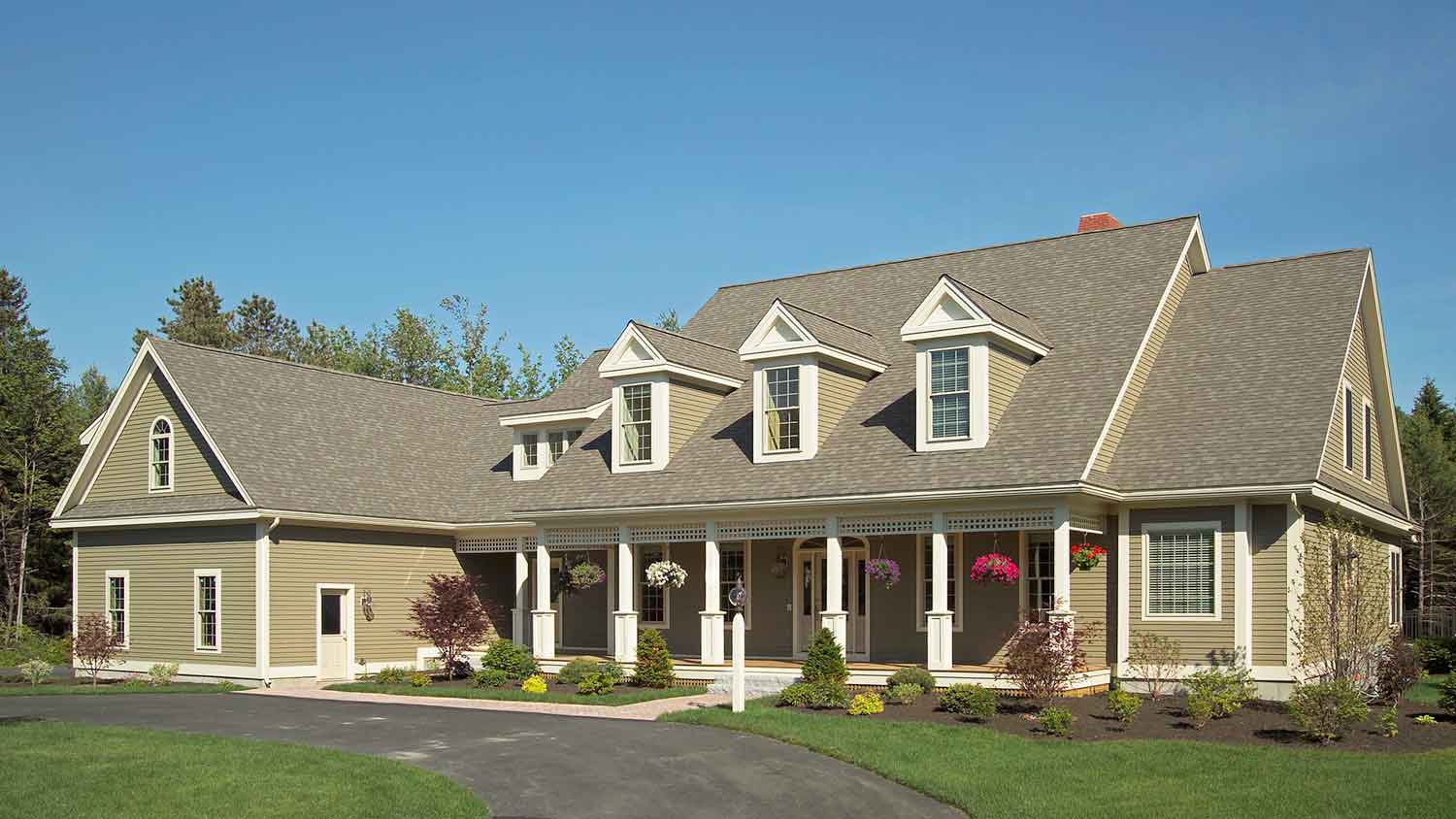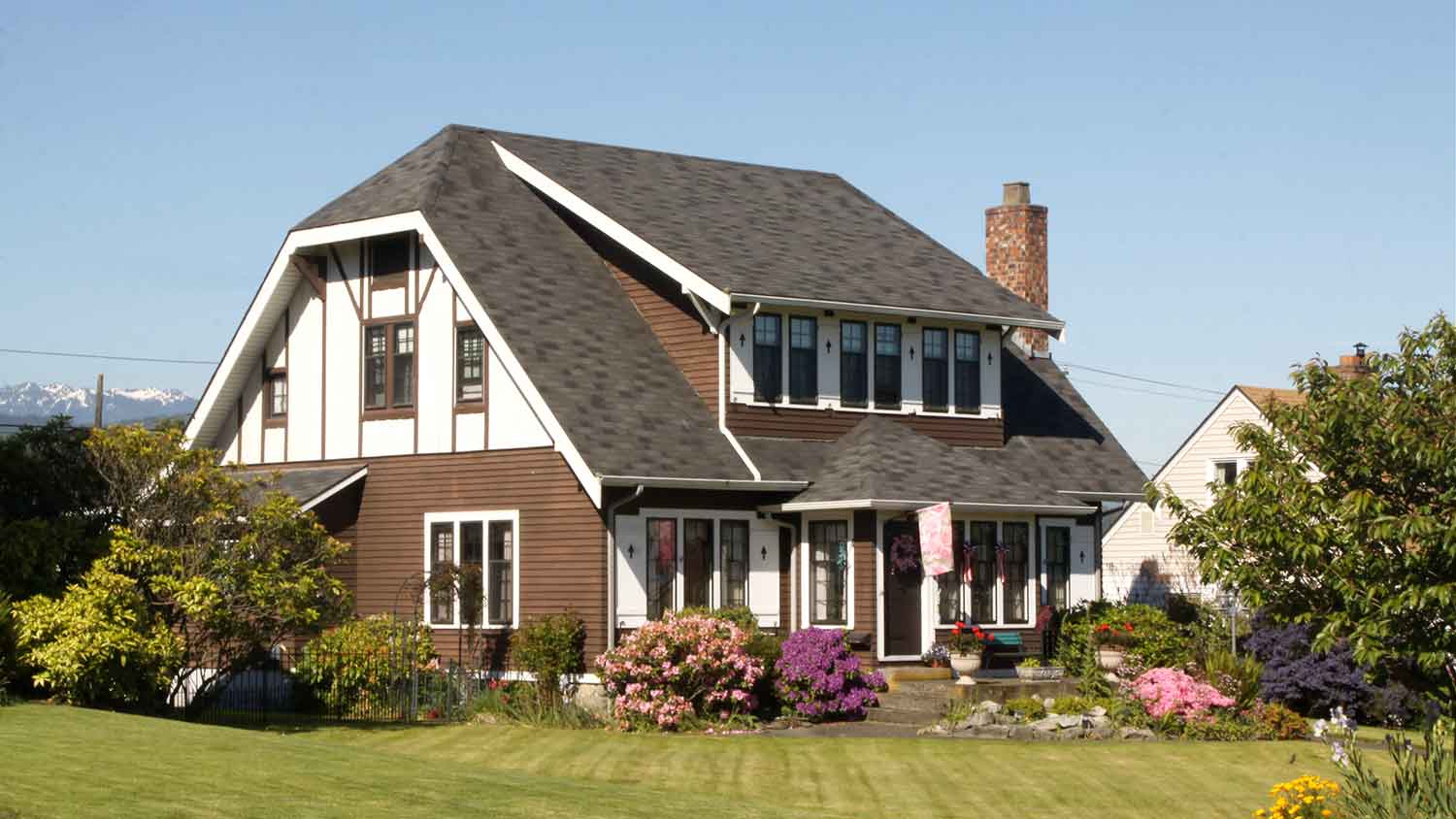7 Best Types of Gable Roofs for Homes
Tried-and-true gable roof designs are no gamble


When choosing a roof for your home, selecting one of the popular types of gable roofs offers a tried-and-true classic design that stands up to the test of time. In this guide, we’ll explain all of the different types of gable roofs that you can choose from, each providing a different style and unique look to your home.

1. Box Gable

The box gable roof has a ridge running along the length of the home with two equal slopes extending outward. The distinguishing feature that sets it apart from the basic open gable design is two triangular shapes that protrude outward from the structure of the home along the narrow ends. These sections deliver extra overhangs to protect the lower part of the home from rain.
| Pros | Cons |
|---|---|
| Sheds rain quickly | Issues in high wind |
| Easy construction | More expensive |
Best for: Homes with minimal exposure to extremely high winds
2. Cross Gable

The cross gable roof is the most complex design among gable roofs. A cross gable roof sits over an L-shaped home, with a gable that intersects the main gable design with a perpendicular section. The cross gable design looks complex, and building it does require more construction materials than a basic open gable roof. However, it adds to your interior living space, which should increase the value of your home.
| Pros | Cons |
|---|---|
| More versatility | Pricey to build |
| Adds interior space | Extra materials |
| Attractive design | Wind damage issues |
Best for: Homes that require extra interior living space
3. Dutch Gable

The Dutch gable roof might have a design that least resembles the traditional gable roof. Some people describe it as two roofs in one, as it resembles a hip roof and gable roof combined. The Dutch gable roof has a long peak in the middle, but it also has four slopes that extend outward over each side of the home, with the two side slopes only descending part of the way down the ends of the main gable. This design is visually pleasing and adds some intrigue to an otherwise simple roof design.
| Pros | Cons |
|---|---|
| Unique appearance | More complex design |
| Allows extra windows | Expensive |
Best for: Homeowners who want a unique appearance on their gable roof.
4. Front Gable

With the front gable roof, the front door is under a separate gable that extends from the main gable. This design can create an impressive look for a home that’s on a narrow lot with minimal space facing the street. Many homeowners will add columns or a small porch to frame the front door, adding more curb appeal.
| Pros | Cons |
|---|---|
| Front door emphasis | Not for big homes |
| Perfect for porches | Possible wind damage |
Best for: Homes on a long, narrow lot
5. Open Gable

The open gable roof is the most common and basic gable roof design available. It features a peak down the middle and equal slopes on either side. It has no extra design elements, although you may sometimes see the gable split among levels, as in the picture above. Thanks to the open gable design, you often receive plenty of interior space in the attic for storage or living space. However, the large, unobstructed side walls of the home can make it susceptible to damage during wind storms.
| Pros | Cons |
|---|---|
| Traditional design | Prone to wind issues |
| Inexpensive | Sharp ceiling slope |
Best for: Homes that want an inexpensive, traditional roof design
6. Gambrel Roof

When you picture an old Dutch-style barn in your mind, you’ll probably imagine it with a gambrel roof. It’s in the gable roof design family because it has a centered peak for the longest dimension of the home. Rather than two equivalent slopes extending from the peak, though, the gambrel design splits each slope into two pitches. The inner slopes (closest to the main peak) have shallow angles, while the outer slopes have sharper angles. This design delivers more attic space than any other gable design. However, it may struggle to shed melting snow from the shallow-angled inner slopes.
| Pros | Cons |
|---|---|
| Visual appeal | Sheds snow poorly |
| More attic space | Expensive |
Best for: Homes that want added attic space
7. Saltbox Roof
A saltbox roof is similar in structural design to an open gable roof, but one slope extends further down than the other, creating an asymmetrical design. This makes for a visually appealing structure that sheds rain well, but the tall, exposed side walls are more susceptible to damage from strong winds.
As such, saltbox roofs are best in areas that don’t see extreme weather, like hurricanes, tropical storms, or tornadoes. One other thing to consider is that the side of the home with the shallower slope provides more attic space or interior living space than an open gable roof.
| Pros | Cons |
|---|---|
| Visual appeal | Prone to wind damage |
| More attic space | Uneven interior space |
Best for: A unique appearance with added attic or living space
Home Styles That Pair Well With Gable Roofs
Gable roofs are the standard among homes in the U.S., primarily because they pair so well with a variety of home styles.
A-frame homes: A-frame homes often use simple gables with steep slopes that extend all the way to the ground.
Bungalow: Two key features of a bungalow are the small footprint and low cost. Since gable roofs are some of the simplest to construct, they do well in low-cost bungalow homes.
Cape cod: Cape Cod homes traditionally have simple gable roofs with doghouse dormers.
Colonial: A staple of Colonial-style homes is a simple gable roof with multiple box gables on the ends of the home.
Dutch Colonial: Dutch Colonial homes often feature Dutch gables or cross gable roofs that have a simple gable running along the length of the home and Dutch gables extending forward for adornment.
Greek Revival: Homes that fall under the Greek Revival style usually have low-slope gables and front gables supported by large, decorative columns.
Modern: Some modern homes feature low-slope saltbox gables for a unique take on a traditional style.
Ranch: Ranch-style homes include a single floor, so the limited attic space offered by an affordable gable roof isn’t much of a concern.
Tudor: The Tudor style often includes Dutch gables adorned with cross gables for a unique, traditional appearance.
Victorian: Victorian homes often have steep gable roofs as their main focal point, with decorative elements to dress up the more traditional design.
What You Need to Know About Gable Roofs vs. Other Designs
The various types of gable roofs are popular in the United States because of their traditional design and because they can successfully handle rain and snow. Compared to other roof types, they boast some appealing pros.
Gable vs. flat roofs: Although a gable roof could suffer more damage in severe wind storms versus a flat roof, it outperforms a flat roof in allowing rain and snow to flow away.
Gable vs. hip roofs: With a gable roof versus a hip roof, the gable roof is clearly better for combatting snow and ice accumulation due to steeper slopes. The hip roof can withstand hurricane-force winds better with its slopes on all sides, but it’s also more complex and more expensive when you hire a roofer to install it.
Gable vs. shed roofs: Both shed roofs and gable roofs may struggle to avoid damage in high wind, but steep shed roofs tend to have more issues with the wind than gable roofs. Gables also tend to have steeper slopes that shed rain and snow more efficiently.
If you are unsure whether you want a gable roof or another type of roof for your new home construction, reach out to a local roofing company for help and accurate roofing cost estimates.





- Roofers
- Metal Roofing
- Roof Repair
- Roof Inspection
- Vinyl Siding Repair Contractors
- Flat Roofing Companies
- Commercial Roofing
- Emergency Roofing Companies
- Leaky Roof Repair
- Metal Roof Repair
- Business Roof Repair
- Flat Roof Repair
- Tile Roof Repair
- Slate Roofers
- Rubber Roofers
- Roofing & Siding
- Metal Roof Installation
- Affordable Roofing
- Roof Sealing
- Attic Ventilation Contractors
- What Is a Gable Roof on a House?
- 8 Gable Roofing Pros and Cons to Know About
- What Is a Gable Vent and What Does It Do?
- Hip Roof vs. Gable Roof: What’s the Difference?
- 14 Common Roof Types and Their Pros and Cons
- Gable Vents vs. Ridge Vents: Pros, Cons, and Costs
- Ridge Vents and Gable Vents: Can You Combine Them?
- How to Build a Roof For Your Home, From Start to Finish
- Roofing Terms and Definitions Every Homeowner Needs to Know
- What Is a Gambrel Roof?










